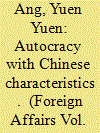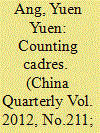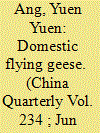|
|
|
Sort Order |
|
|
|
Items / Page
|
|
|
|
|
|
|
| Srl | Item |
| 1 |
ID:
158867


|
|
|
|
|
| Summary/Abstract |
Sooner or later this economy will slow,” the New York Times columnist Thomas Friedman declared of China [1] in 1998. He continued: “That’s when China will need a government that is legitimate. . . . When China’s 900 million villagers get phones, and start calling each other, this will inevitably become a more open country.” At the time, just a few years after the fall of the Soviet Union, Friedman’s certainty was broadly shared. China’s economic ascent under authoritarian rule could not last; eventually, and inescapably, further economic development would bring about democratization.
|
|
|
|
|
|
|
|
|
|
|
|
|
|
|
|
| 2 |
ID:
119182


|
|
|
|
|
| Publication |
2012.
|
| Summary/Abstract |
Is China's public bureaucracy overstaffed? To answer this basic question objectively, one needs to define public employment in the contemporary Chinese context; survey data sources available to measure public employment; and finally, compare China's public employment size with that of other countries. Using a variety of new sources, this article performs all three tasks. It also goes further to clarify the variance between bianzhi (formally established posts) and actual staffing size, as well as other permutations of the bianzhi system, especially chaobian (exceeding the bianzhi). A key finding is that China's net public employment per capita is not as large as often perceived; quite the contrary, it is one-third below the international mean. However, it is clear that the actual number of employees in the party-state bureaucracy has grown - and is still growing - steadily since reforms, despite repeated downsizing campaigns. Such expansion has been heavily concentrated at the sub-provincial levels and among shiye danwei (extra-bureaucracies).
|
|
|
|
|
|
|
|
|
|
|
|
|
|
|
|
| 3 |
ID:
159841


|
|
|
|
|
| Summary/Abstract |
This study illuminates the important yet under-studied phenomenon of industrial transfer in China: the migration of capital and investment from wealthy coastal areas into poorer central and western provinces, beginning in the 2000s. By 2015, the value of domestic investment in five central provinces alone was 2.5 times that of foreign investment throughout China. Compared to the original “flying geese” model of tiered production in Asia, China's experience is distinct in three ways: (1) industrial transfer occurred domestically, rather than across nations; (2) sub-national transfer followed cross-national transfer; and (3) industrial migration is accompanied by a delayed replication of government policies and practices. While coastal locales today resolve to expel low-end industries, inland governments cannot afford to be selective and have only recently adopted the aggressive investment promotion tactics that coastal cities abandoned years ago. Policy diffusion is delayed as policy adoption depends on economic conditions, which vary widely across China and change over time.
|
|
|
|
|
|
|
|
|
|
|
|
|
|
|
|
| 4 |
ID:
193214


|
|
|
|
|
| Summary/Abstract |
In 2005, the Chinese government deployed a new financial instrument to accelerate technological catch-up: government guidance funds (GGFs). These are funds established by central and local governments partnering with private venture capital to invest in state-selected priority sectors. GGFs promise to significantly broaden capital access for high-tech ventures that normally struggle to secure funding. The aggregate numbers are impressive: by 2021, there were more than 1,800 GGFs, with an estimated target capital size of US$1.52 trillion. In practice, however, there are notable gaps between policy ambition and outcomes. Our analysis finds that realized capital fell significantly short of targets, particularly in non-coastal regions, and only 26 per cent of GGFs had met their target capital size by 2021. Several factors account for this policy implementation gap: the lack of quality private-sector partners and ventures, leadership turnover and the inherent difficulties in evaluating the performance of GGFs.
|
|
|
|
|
|
|
|
|
|
|
|
|
|
|
|
|
|
|
|
|